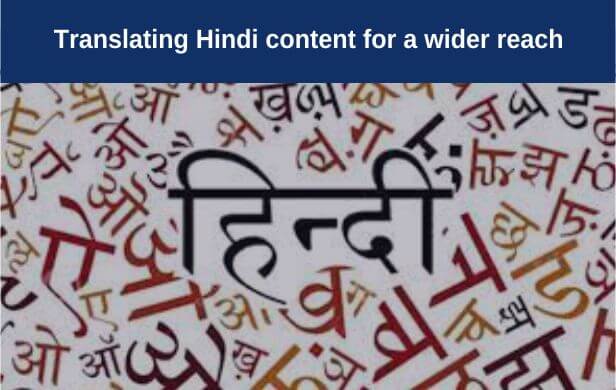
Businesses and content creators constantly seek ways to expand their reach beyond their regular markets. One of the most promising avenues for growth lies in emerging markets, where rapid economic development and increasing internet penetration present significant opportunities. Hindi, as one of India's most widely spoken languages, plays a crucial role in tapping into these markets. However, to fully harness this potential, translating Hindi content for a wider reach is essential. In this blog, we will delve into the significance of emerging markets, explore the power of Hindi content, and discuss strategies for effective translation.
Emerging or developing markets are economies that are rapidly advancing toward industrialization, urbanisation, and increased consumer spending. These markets are characterised by their expanding middle class, rising disposable incomes, and growing digital connectivity.
As these markets evolve, the demand for accessible and relevant content continues to surge. Catering to diverse cultures, languages, and preferences becomes crucial in engaging with these audiences. This is where the power of language, particularly Hindi, comes into play.
Hindi, as the most spoken/understood language by millions in India and several other countries, holds immense potential for reaching audiences across diverse cultural and linguistic backgrounds. With a Hindi-speaking population now spread across the globe and increased digital adoption, Hindi content can serve as a bridge to connect with emerging markets. Leveraging Hindi content enables businesses to tap into the emotional resonance of the language, establish cultural relevance, and create a strong bond with consumers.
Effective translation goes beyond mere word-for-word conversion. It involves cultural adaptation, ensuring that the content resonates with the target audience's beliefs, customs, and preferences. Localise not just the language but also visuals, symbols, and idiomatic expressions.
While machine translation tools can be handy to understand the gist of some content, investing in professional human translators ensures accurate and culturally sensitive translations. Quality translations reflect positively on your brand's commitment to understanding and valuing the target market.
While adapting content, retaining the core essence and authenticity is essential. Striking the right balance between localization and maintaining the original intent ensures a meaningful connection with the audience.
Different platforms have different communication styles. Whether it's social media, websites, or video content, tailor your translations to fit the platform's norms and user behaviour.
Engage with your audience to gather feedback on translated content. This feedback loop helps refine your translation strategies over time, leading to better engagement and resonance.
Collaborating with local influencers, bloggers, experts, and translation services can significantly boost your content's credibility and reach. They understand the cultural nuances and can help tailor your content for maximum impact.
While translating Hindi content for a wider reach can be incredibly rewarding, it's important to acknowledge the challenges that come with it. Language is a complex and nuanced aspect of culture, and ensuring accurate and culturally sensitive translations requires careful consideration. Here are some challenges you might encounter:
Languages are deeply intertwined with cultural contexts and nuances. Certain words, phrases, or expressions that make sense in Hindi might not have direct equivalents in other languages. Translations need to be well-versed in both the source and target cultures to capture the true essence of the content.
Like any other language, Hindi is filled with idiomatic expressions with unique meanings. Translating these expressions directly might result in confusion or misinterpretation. Skilled translators are needed to find equivalent idiomatic expressions in the target language.
The tone and voice of content play a significant role in connecting with the audience. Maintaining the appropriate tone, whether it's formal, informal, conversational, or persuasive, can be challenging during translation. Using the right tone and voice ensures that the translated content resonates with the audience in the same way as the original.
Different cultures have varying levels of sensitivity towards certain topics. Content that is perfectly acceptable in one culture might be offensive in another. Translations must be made with these sensitivities in mind to avoid inadvertently causing misunderstandings or negative reactions.
Since the Hindi language uses the Devnagri script, which is different from English or other European languages, using the correct Unicode or other fonts that work on the target format like DTP software or on websites/in Apps is crucial so that the localized content is visible correctly.
Though the purists would not agree, finally, the ultimate purpose of the content is communication, and therefore the use of Hinglish is inevitable to reach Pan India where the pure form of Hindi is unknown to many in the professional world. Therefore using the right balance of Hinglish and Hindi is key for any document to be understood well across India if it is not targeted, especially to small towns or the Northern Part of India where pure Hindi is more commonly understood.
Documents published in Hindi are difficult to understand for non-Hindi speakers both in India and abroad. Hindi to English translation services of official documents, project documents, legal documents, and regulations need to be translated into English to be easily understood by the non-local business population for conducting business in the region.
Emerging markets offer a wealth of opportunities for businesses and content creators to expand their reach and impact. Hindi, with its extensive global reach, holds the key to unlocking these opportunities. However, effective translation is not just about converting words; it's about bridging cultures, establishing connections, and building lasting relationships. By embracing localization, authenticity, and cultural sensitivity, businesses can successfully adapt Hindi content for a wider Pan-India reach, fostering meaningful engagement with emerging markets and achieving long-term success.
For any queries related to language translation services. Inquire at our email address below or give us a call today!
info@languageservicesbureau.com
Telephone: +91-20-24470509, +91-82370 60559
Similar articles for you...

आमच्या गेल्या महिन्यातील ब्लॉग मध्ये भाषांचे ज्ञान आवश्यक असणाऱ्या करियर क्षेत्रांची माहिती आपल्याला मिळाली. जिथे भाषेचे ज्ञान फायद्याचे ठरते असे इतर व्यवसाय आपण या महिन्यात पाहुयात.

Posted by : Language Services Bureau

The time it takes to learn a language depends on what you want to do with it– here is a great article about language learning and the kind of expectations you can set about the time required for the same!